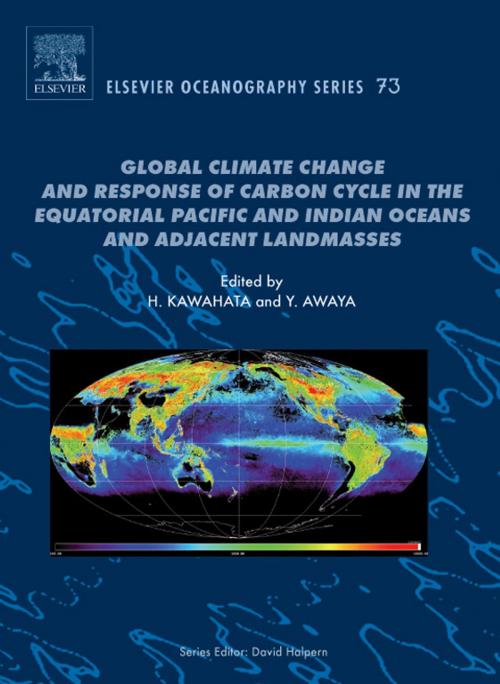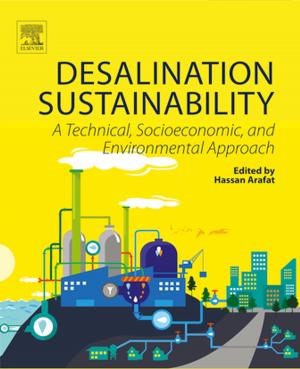Global Climate Change and Response of Carbon Cycle in the Equatorial Pacific and Indian Oceans and Adjacent Landmasses
Nonfiction, Science & Nature, Science, Earth Sciences, Nature| Author: | ISBN: | 9780080469416 | |
| Publisher: | Elsevier Science | Publication: | December 8, 2006 |
| Imprint: | Elsevier Science | Language: | English |
| Author: | |
| ISBN: | 9780080469416 |
| Publisher: | Elsevier Science |
| Publication: | December 8, 2006 |
| Imprint: | Elsevier Science |
| Language: | English |
To understand the global warming mechanism, global mapping of primary production was carried out under the GCMAPS program. The program was concerned with marine and terrestrial environmental changes, which affect carbon cycle on the regional and global scales. On the regional scale, warm phase of ENSO (El Niño / Southern Oscillation) has been shown to affect economic activities in many countries. The keyword for understanding mechanism of global warming is ‘primary productivity’. The earth observation satellites (EOS) like the ADEOS of Japan, and the SeaWiFS, Sea Star and Terra of the U.S.A. provided much required data for modeling and verification of primary production estimates on both land and ocean.
The knowledge gained during the GCMAPS program has been documented in this book. Interpretation of the data suggests that global warming, which causes temperature and sea level rise, and changes in climate and ecosystems, is likely to have the largest influence on mankind. The first half of this book discuss changes in marine environments. Physical and chemical oceanographic properties of the equatorial Pacific and Indian Oceans are presented. Changes in partial pressure of carbon dioxide, flux and composition of settling particles and biological communities in the surface ocean have also been discussed. In addition to this, over hundred years of environmental records based upon coral skeletons are presented. Estimations of primary production and its utilization in validating satellite imagery data were conducted in the western North Pacific. Primary productivity estimates based upon the validated satellite imagery are presented on the global scale. Climate change modeling of primary production in global oceans is also presented.
The latter half of this book deals with changes in terrestrial environments. Primary productivity estimates for different types of ecosystems (e.g., forest, grassland) are presented together with soil carbon dynamics. Also, biomass and productivity estimation and environmental monitoring based upon remote sensing techniques are presented with a model analysis of the relationship between climate perturbations and carbon budget anomalies in global terrestrial ecosystems. This book elucidates integrated aspects of the global carbon cycle involving marine and terrestrial environments.
- Discusses a current understanding of the biogeochemical processes on land and ocean
- Provides global mapping of primary production based on satellite imagery data and modelling
- Presents the latest interpretations of relationships between carbon cycle and climatic change
To understand the global warming mechanism, global mapping of primary production was carried out under the GCMAPS program. The program was concerned with marine and terrestrial environmental changes, which affect carbon cycle on the regional and global scales. On the regional scale, warm phase of ENSO (El Niño / Southern Oscillation) has been shown to affect economic activities in many countries. The keyword for understanding mechanism of global warming is ‘primary productivity’. The earth observation satellites (EOS) like the ADEOS of Japan, and the SeaWiFS, Sea Star and Terra of the U.S.A. provided much required data for modeling and verification of primary production estimates on both land and ocean.
The knowledge gained during the GCMAPS program has been documented in this book. Interpretation of the data suggests that global warming, which causes temperature and sea level rise, and changes in climate and ecosystems, is likely to have the largest influence on mankind. The first half of this book discuss changes in marine environments. Physical and chemical oceanographic properties of the equatorial Pacific and Indian Oceans are presented. Changes in partial pressure of carbon dioxide, flux and composition of settling particles and biological communities in the surface ocean have also been discussed. In addition to this, over hundred years of environmental records based upon coral skeletons are presented. Estimations of primary production and its utilization in validating satellite imagery data were conducted in the western North Pacific. Primary productivity estimates based upon the validated satellite imagery are presented on the global scale. Climate change modeling of primary production in global oceans is also presented.
The latter half of this book deals with changes in terrestrial environments. Primary productivity estimates for different types of ecosystems (e.g., forest, grassland) are presented together with soil carbon dynamics. Also, biomass and productivity estimation and environmental monitoring based upon remote sensing techniques are presented with a model analysis of the relationship between climate perturbations and carbon budget anomalies in global terrestrial ecosystems. This book elucidates integrated aspects of the global carbon cycle involving marine and terrestrial environments.
- Discusses a current understanding of the biogeochemical processes on land and ocean
- Provides global mapping of primary production based on satellite imagery data and modelling
- Presents the latest interpretations of relationships between carbon cycle and climatic change















